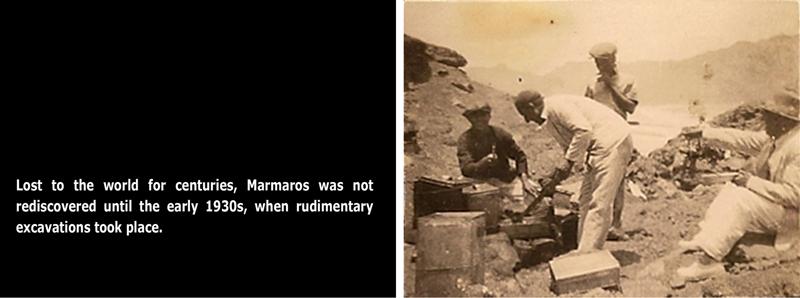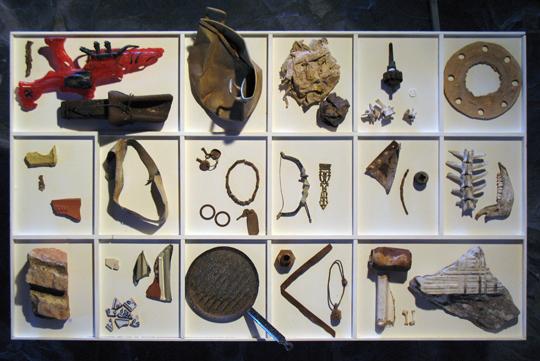


Marmaros was "rediscovered" during a joint residency in Portugal in August 2008. We were situated at OBRAS in the Alentejo region of the country near the towns of Estremoz, Borba and Evora. Driving from the Spanish border towards Estremoz for the first time we saw what appeared to be a white city shimmering on a distant hill. The mirage dissolved within seconds to reveal blocks of marble, piled skywards. As we drove on the presence of marble in the region was hard to ignore. Yet the marble industry had been in decline for a number of years. Out of 400 quarries only a handful were in working order. The rest remained like potchmarks on the landscape.Companies, under obligation to fill in fully quarried sites, had purposefully left a small amount of rock in each one to save on remediation costs. As a result, these open pits were a locus of bad feeling and used as fly-tipping sites. It’s partly this that prompted us to explore them anew, and partly their structural magnificence. As outsiders, with no prior knowledge of Portugal´s industrial past, it was easy for us to imagine them as rock cut cathedrals, positive constructions as opposed to negative remains. We were struck by the architectural suggestiveness of the sites and thought, “what if these weren’t quarries, but remnants of a prehistoric civilization?”


From this point on we set out to uncover an alternative history to the quarries, exploring their narrative potential through the prism of a fictitious lost culture. We looked for clues in the quarries themselves, in the stories of people we met and in the artifacts that fell across our path. We gathered visual, sonic, physical and anecdotal evidence; Things that pointed to an alternate story of construction. Borrowing from other rock cut heritage sites, and drawing on archaeological conventions we then ordered the clues we’d ´found to hint at a new story - that of the Marmaros. Breaking down textual accounts of sites such as Petra and Lalibela exposed rock-hewn wonders to have their own specific discourse, a discourse we borrowed to give linguistic parameters and a historical chronology to the Marmaros. Objects excavated from the site gave the narrative further physicality, and little by little the story grew. Pro-Evora (the organisation responsible for the preservation of heritage in the area) hosted our findings in September 2008. The exhibition consisted of text, drawings, video, photographs and objects, which taken together tentatively reordered information and received wisdom surrounding the quarries.

Still from Rediscovering Marmaros: (2008) Video: 2"16", 4:3: PAL, Colour


Artifacts: (2008) Found objects, wood, paint, 150 x 80 x 120cm

Shadowmap: Site Specific Performance: 30mins
Our intention in creating this work was not to be prescriptive. We weren’t trying to fool people or create a hoax. Our interest lay in instigating a new and open-ended narrative around the quarries; to playfully re-contextualise information to suggest new meaning. We did not want people to believe, but to momentarily suspend disbelief. We wanted to construct a story that would sit alongside, rather than cut across, local sensibilities; a story that would inspire wonder in making the usual unusual. Rearranged items of rubbish thus became treasured cultural artifacts, whilst at the same time remaining completely untransformed. We didn’t want the joke to be on the viewer, but to rest in a third space, somewhere between the work, the viewer and existing perceptions. So whilst at one level the quarries were just quarries, when viewed through the prism of the Marmaros, they simultaneously resonated with a whole host of other meanings. In presenting the project we found the gap between these two incongruous readings of the same to be a humorous space that people could engage with.
In uncovering the Marmaros we purposefully kept the narrative open and incomplete in order that people encountering it could shape it further, becoming active agents themselves. We saw our role as setting parameters for a myth that would continue to grow after we had left, taking on a life of its own. In this respect we encouraged people to feed in ideas and take ownership of the story as it developed. It’s our hope that the myth of the Marmaros will continue to grow and slowly infiltrate Portuguese consciousness.
©Trish Scott 2009
Trish and Dan Scott "The Lost World of Marmaros" (2008)
Trish Scott is a mixed media artist, working with both objects and performance, and currently based in London. http://www.trishscott.org
Dan Scott is a musician and sound artist currently based in London. His art work focuses on the role of sound as a vehicle of memory and narrative. http://www.happybandofjapan.org